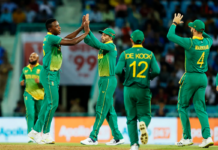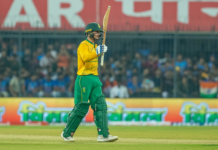Among the sporting world’s biggest rivalries, India vs. Pakistan in cricket is as big as it gets.
On Sunday, these competitors faced off for the first time in the USA, which is not only the most lucrative sports market in the world, but also home to 5 million people of Indian descent and close to 700,000 of Pakistani heritage.
So for this T20 World Cup match in New York, anticipation was incredibly high.
And it did not disappoint.
Indeed, it was the most viewed sporting event held on US soil since the 1996 Atlanta Olympics Opening Ceremony. The broadcast audience exceeded that of any single American football, basketball, baseball, soccer, or hockey match by many multiples.
Advertisers wishing to insert themselves into this mix paid a hefty price. TV ad spots on the Indian broadcast for the match were going for Rs 4 million for 10 seconds, 33% higher than the Rs 3 million price during the 2023 World Cup held in India.
In person, the capacity crowd of 34,028 in New York’s Nassau County International Cricket Stadium, having shelled out top dollar for the event, was bursting with energy. They braved multiple rain delays, and then reused their umbrellas in the sun when perfect weather emerged for the remainder of the match.
The crowd was roughly 85% India supporters and 15% Pakistan supporters – reflecting the make-up of the local immigrant populations. Indeed, it often felt like an Indian home match. In fact India’s Jasprit Bumrah, awarded Player of the Match for his dazzling 3-for-14 spell, said afterwards: “It didn’t feel like we weren’t playing in India.”
Cricketing royalty was out in force from both countries: Pakistani National Team emeriti Wasim Akram, Waqar Yunus, and Shahid Afridi all took the field pre-match. Former Indian international Sachin Tendulkar was there, much to the delight of the crowd, as was Yuvraj Singh, who ceremoniously brought the World Cup trophy onto the field.
The loudest cheer, though, came for the “Six Machine” himself, Chris Gayle – one of many neutrals turning out to partake in the historic event.
The match did not disappoint either – a thriller coming down not only to the final over, but to the last few balls. Pakistan bowled India out for 119 – the first time in history India had been bowled out in a T20I. India, led by Bumrah, held Pakistan to 113 and pulled off an unlikely victory.
Without question though, the biggest winner was the sport of cricket. This quality of match with this level of attention helps grow the sport, and drives tremendous benefit for all parties and stakeholders involved.
That said, given the magnitude of the moment – the audience, the economics, and the match – the decade-old elephant in the stadium was hard to ignore.
Know thy enemy?
What is truly unusual about India vs. Pakistan, especially in recent years, is how rarely these teams meet and how – relatively speaking – unfamiliar the players are with one another.
In other sports rivalries, more is better. Barcelona and Real Madrid face off in the Classico at least twice a year, sometimes thrice or more. The Yankees and Red Sox play at least a dozen times a year. Nobody feels like the number of games dilutes the level of excitement.
Pakistan and India used to compete much more regularly until the 2008 Mumbai attacks, when relations between the two countries took a turn for the worse.
A short-lived thaw in 2011-2012 led to India’s PM Manmohan Singh inviting his Pakistani counterpart, Yousuf Gilani, to attend the Semi Final between the two countries in Mohali. It also led to the last bilateral series between the countries in December 2012/January 2013.
Since then, however, Pakistan and India have only met in ICC and ACC limited overs tournaments. They have played no test matches, only 11 ODIs, and Sunday was just their 8th T20I. They are averaging less than one match per limited overs format per year.
By contrast, since 2010, between England and Australia (cricket’s other major national rivals), there have been 40 Ashes Tests, 55 ODIs and 19 T20Is.
As Sunday demonstrated, this is collectively leaving a lot on the table, not only financially, but in terms of opportunities to grow the sport.
Missing out on cricket’s globalization
There have been previous periods when India and Pakistan halted competition for political reasons. Cricket stopped between 1961 and 1978, and again between 1989 and 2004.
But this past decade has been different – as it has come during cricket’s T20 boom era.
A hallmark of this period is that top players from different cricketing nations are becoming teammates in T20 franchise leagues such as the IPL, Big Bash, PSL, CPL, and The Hundred, among others, and are developing strong friendships and professional familiarity.
By contrast, the top Indian and Pakistani players are missing out on one another.
India’s players are not allowed by the BCCI to play in any overseas league, much less the PSL.
The first edition of the IPL – the only one to take place before the Mumbai attacks – featured 11 Pakistani players. But since the 2008 attacks, the BCCI has not allowed Pakistani players to play in the IPL.
There have also been reports that IPL team owners investing in other franchise leagues have been reluctant to sign Pakistanis as well, lessening the chances of Indian and Pakistani stars ever becoming teammates.
As a result of this, the disconnect between the two teams is large and growing, and a sporting generation has now passed through this era.
To put it in perspective: Virat Kohli, arguably cricket’s most high profile star, has never played a match in Pakistan.
Room to grow?
Obviously the root of the challenge lies in the India-Pakistan bilateral relationship, which is one of the most high-stakes and complex in the world. They have fought four wars, and their cricket rivalry is dwarfed in significance by their nuclear rivalry. In India’s most recent election campaign this past May, as is regularly the case, rhetoric about Pakistan was prominent in accusations between rival parties.
That said, while we are not naive, and we do not pretend to be experts on South Asian geopolitics, Sunday’s events give us glimmers of hope.
The New York crowd was loud and intense, but by and large friendly and no incidents were reported. Fans of both sides were having good fun among themselves and with each other.
One of the most poignant moments of the day happened off camera. When Rohit Sharma and Babar Azam, India and Pakistan’s respective captains, took the field just before the televised coin toss, they shared a very genuine hug and a friendly chat.
Finally, coinciding with the match on Sunday, India’s Prime Minister Narendra Modi Narendra Modi was sworn in as India’s prime minister for a third term at the presidential palace in Delhi – making him just India’s second three-term Prime Minister since Jawaharlal Nehru. There are many who speculate that Modi, now well into his 70s, will be thinking more about his legacy. Modi is also openly focused on tackling the threat that China poses to India. And both of those may point to improving relations with Pakistan.
We suggest that cricket would be a great place to start.

















































